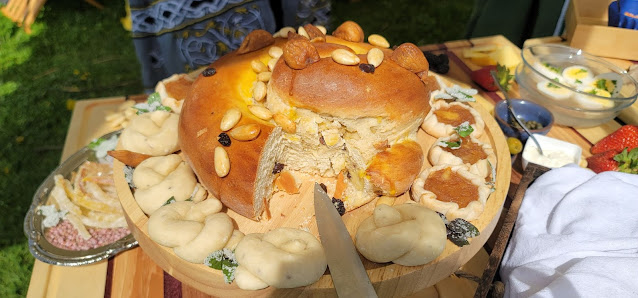Five Medieval Fish Recipes from Harleian MS 279
 |
| Iuselle of Fish, adapted from Harleian MS 279 — a delicate almond milk and saffron broth served with root vegetables, fruit, and rustic bread. |
From fasting feasts to Friday fare, fish played a key role in medieval English cooking. Harleian Manuscript 279, compiled around 1430, contains dozens of fish recipes revealing the rich, layered flavors and creative preparations used in upper-class kitchens. Below are five standout dishes from that manuscript, all adapted or interpreted for the modern cook.
1. Tench Three Ways
Read the full recipe and interpretation
This unique entry shows off the versatility of medieval fish cookery. The tench is served boiled, in a broth, and roasted — each with different sauces or seasonings, ranging from parsley-based green sauce to a pottage enriched with almond milk and spices.
2. Mortrews of Fish
Read the full recipe and interpretation
Here, fish is cooked and then pounded smooth with breadcrumbs and flavorful ingredients like almond milk, saffron, and sugar. Served warm and thick, this dish is a satisfying meatless main and an excellent example of medieval texture-forward cooking.
3. Sturyon in Broth
Read the full recipe and interpretation
This spiced broth balances vinegar, pepper, and saffron to create a sharp yet warming sauce for chunks of fish — originally sturgeon, but modern substitutions like salmon or cod work just as well.
4. Iuschelle of Fish
Read the full recipe and interpretation
“Iuschelle” refers to a gently spiced dish, somewhere between a stew and a sauce. The fish is flaked and simmered in almond milk, saffron, and breadcrumbs, yielding a light but elegant presentation that fits well as a first course.
5. Roseye – Fish in Rose Sauce
Read the full chicken version (fish variation included)
Although your blog post features the chicken version, the original recipe allows for fish as well. The dish combines fried fish with a saffron-almond-rose sauce colored naturally with rose petals. It’s a fragrant, subtly sweet, and visually stunning dish — perfect for a final course or Lenten feast.
Historical Context
Harleian MS 279 reflects the dietary rules and creativity of the 15th-century English court. With meat forbidden during fast days, cooks leaned into fish, legumes, and dairy alternatives like almond milk. The use of fragrant spices, vinegars, and herbal sauces made these dishes anything but bland — and many remain surprisingly approachable for the modern table.
Want to Try One?
Leave a comment or tag me if you cook one of these! For printable versions, check out the recipe cards on Ko-fi. You can also browse other fasting-friendly or Lenten dishes using the tags at the bottom of each post.
🐚 More Historical Shellfish Recipes
Explore more Fish Recipes and Fasting Dishes on the blog.
Sources: Harleian MS 279, Curye on Inglysch, Two Fifteenth-Century Cookery Books






